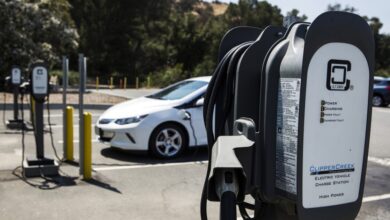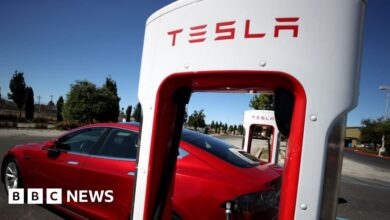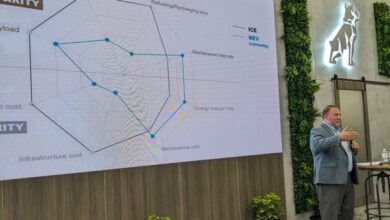The Slowdown in US Electric Vehicle Sales Looks More Like a Blip

(Bloomberg) — After an underwhelming start to the year for US electric-vehicle sales, it might seem easy to conclude that the boom times are over. Sales were flat in the first quarter, Ford dramatically scaled back expansion plans and Tesla laid off 10% of its global workforce. But these dismal indicators only tell part of the story.
For every sign of an EV slowdown, another suggests an adolescent industry on the verge of its next growth spurt. In fact, for most automakers, even the first quarter was a blockbuster. Six of the 10 biggest EV makers in the US saw sales grow at a scorching pace compared to a year ago — up anywhere from 56% at Hyundai-Kia to 86% at Ford. A sampling of April sales similarly came in hot.
It’s a tale of two EV markets, where consumers are flocking to some brands in record numbers while turning their backs on those with inferior battery range, slower charging and high prices, said Stephanie Valdez-Streaty, director of industry insights at Cox Automotive. Delays of new vehicles, though temporary, added to the perception of a market running out of steam.
“We’re still seeing growth in demand, just not at the same pace for every brand,” Valdez-Streaty said. “Right now Tesla doesn’t have new models, Ford doesn’t have a lot in the pipeline. But Hyundai, BMW, Kia, Cadillac — they’re really moving the needle forward.”
GM sees 300% growth for 2024
The two companies with the worst start to the year were General Motors and Tesla — both victims, in part, of their own product cycles. This year GM discontinued its most popular EV, the Chevy Bolt, before its replacements were ready, while Tesla Model 3 production was interrupted for a long-planned facelift to the car’s design. Excluding those two models, US EV sales in the first quarter grew a respectable 23% over a year ago, matching pace with global EV sales for the same period.
For the rest of 2024, GM appears to be on the brink of becoming the biggest driver of EV growth in the US. The Detroit automaker has committed to electrifying some of its biggest brands, which are finally reaching production after years of delays. That includes a $35,000 Equinox SUV and its sibling Blazer, as well as Silverado and GMC Sierra electric pickups with up to 450 miles of range.
These vehicles all rely on the new Ultium line of batteries from GM’s joint venture with LG Chem. Problems with those batteries, and with GM’s new EV software, tripped the brakes on the automaker’s EV plans last year. Had Ultium arrived on time, in the numbers GM had predicted, the mood around the US EV market might have been exuberant going into 2024.
GM Chief Executive Officer Mary Barra says Ultium problems are in the rearview, and the company expects to produce 200,000 to 300,000 Ultium-based EVs this year, a potential 50-fold increase from the 5,800 Cadillac Lyrics sold in Q1. “I think it was overhyped and now it’s probably underhyped,” Barra recently said of the US outlook for EVs. “The truth is somewhere in the middle.”
And for all the talk of an EV slowdown, many longer-term forecasts haven’t budged. In April, the International Energy Agency estimated that US sales of fully electric vehicles will soar to 2.5 million in 2025, from 1.1 million last year.
The biggest source of uncertainty for the US outlook is the product pipeline at Tesla, which is responsible for half of the country’s EV market. Tesla relies on just two cars — the Model 3 sedan and the Model Y SUV — for 95% of its sales. It repeatedly slashed prices last year to maintain growth before its first-quarter slump.
Tesla’s calendar of new-vehicle launches is essentially blank, apart from an aspirational Roadster supercar and a vague hint by Elon Musk last month of “new vehicles, including more affordable models,” coming next year. It’s too soon to gauge long-term demand for Tesla’s Cybertruck pickup, which is currently only offered as a $120,000 founders edition.
In August, Tesla plans to unveil a self-driving “Cybercab” without a steering wheel. There’s plenty of uncertainty about the readiness of the underlying technology and about what will propel Tesla sales growth until it’s ready. Adding to the uncertainty is the state of Tesla’s high-speed Superchargers in the US. The company recently opened its network of more than 2,000 US charging stations to non-Tesla owners, who can access the chargers with an adaptor. But in the middle of that transition, Musk fired Tesla’s 500-person Supercharger staff as part of the company-wide layoffs. He has since clarified that Tesla will continue to expand the Supercharger network, albeit at a slower rate, and has hired back some of the dismissed employees.
Mass production is key
Tesla’s gap year leaves an opening for other EV makers, but there’s a self-fulfilling aspect to all the talk of an EV slowdown in the US. Some automakers are concluding from Tesla’s stumbles that they should hold back their own investments until there’s more market clarity, said Corey Cantor, an EV analyst at BloombergNEF. Instead they should be following the lead of Hyundai and GM: Aggressively introduce affordable EV models to build economies of scale.
“Automakers are probably freaking out too much, as usual, but there is a bit of a Tesla issue,” Cantor said. “If they want to start taking market share, or even just perform at a high level, they need to start producing EVs at mass volume.”
No car company besides Tesla has been able to produce a runaway EV success in the US — or sell more than 100,000 EVs a year across its EV lineup. This year Hyundai, GM and Ford are each on track to reach that 100,000 threshold of mass production, a potential turning point for US EV competition.
Some of the biggest EV laggards are also jumping into the US market this year. Stellantis is expected to start selling its first electric Jeeps and Ram pickups and Hyundai is unleashing a diverse stable of EVs for its new factory opening in Georgia in October. Honda just started delivering the Acura ZDX and is building a production hub in Ohio for additional EVs coming in 2025. The list goes on.
US and worldwide EV sales are both expected to grow roughly 20% this year. That’s less than the blistering 46% expansion the US experienced in 2023 — but that level of growth can’t be sustained for long. If the global market for EVs continued at this “slowdown” pace indefinitely, virtually all cars would be electric in a decade.
Read More:
- JB Straubel Built an EV Battery Colossus to Rival China
- Recycling Shatters the Myth of Electric Vehicle Waste
- How Three High-Tech Countries Became EV Laggards
- EVs Pass Tipping Point to Mass Adoption in 31 Countries
©2024 Bloomberg L.P.



